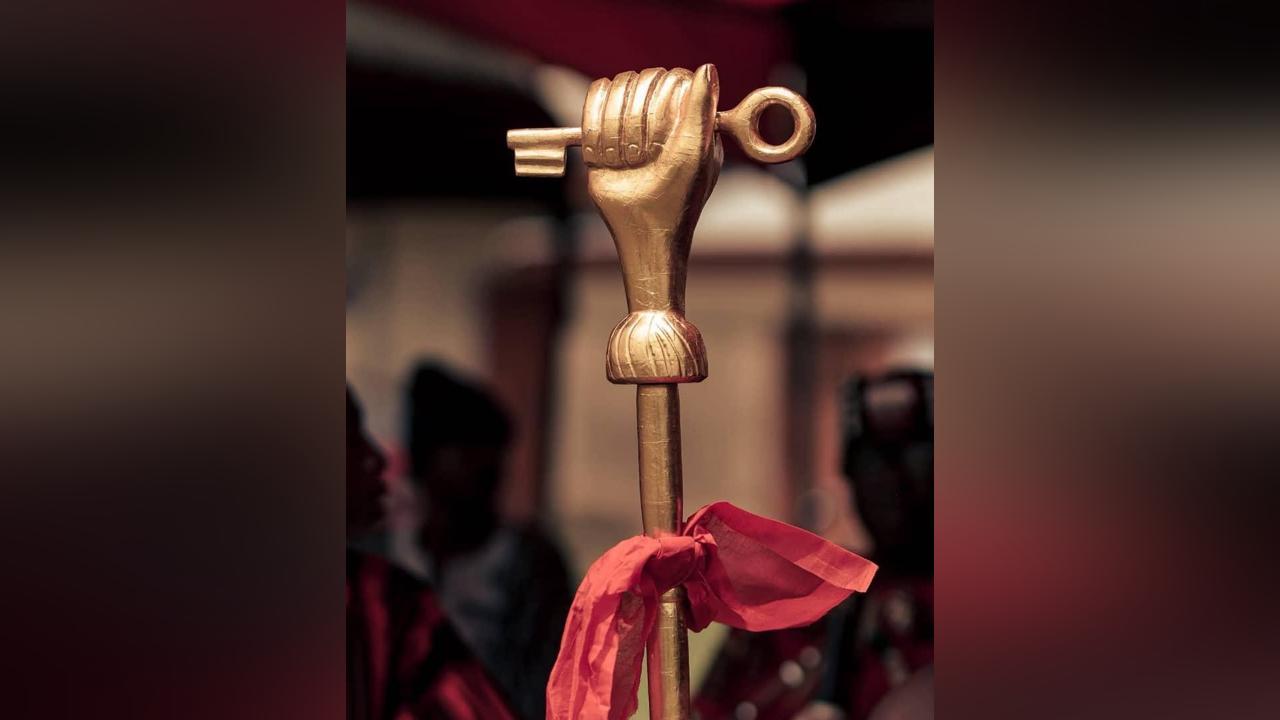Africa-Press – Ghana. Tsiamiti, commonly referred to as the traditional linguist staff, stands as a profound emblem of authority, identity, and collective memory among the Ewe people of Ghana, Togo, and Benin.
The ornate and symbolic staff is carried by spokespersons of kings, chiefs, and queenmothers, embodies not only power and prestige but also the deep philosophical values of the Ewe governance and political heritage, dovetailing into other ethnic groups.
The staff is the official insignia of the linguist and a symbol of their authority, who are messengers of the king, queen in the traditional chiefdom.
Cultural Significance
Cultural experts regard the Tsiamiti as one of West Africa’s most enduring symbols of traditional governance, bridging oral tradition with visual communication.
The Akans, for instance, revere the Okyeame Poma, the linguist staff adorned with gold-leafed carvings that convey proverbs and communal values.
Experts Perspective
“The staff is the authority of the linguist. Without it, the people may not regard the message as coming from the leader,” said Professor Agbewode Kemevor, a scholar of culture and artifacts.
In Ewe political systems, leaders rarely speak directly to their subjects. Instead, linguists convey their words with eloquence and clarity, using the staff as a symbol of legitimacy.
Crafted from wood or metal and often plated with gold or silver, the staff is crowned with a carved finial that represents a proverb or symbolic message.
“These symbols are not mere decorations. They are proverbs in visual form, carrying the wisdom of our ancestors,” explained Professor Komiga Amoako, a researcher on African regalia.
Carvings of animals symbolise vigilance, courage, and wisdom, while stools and human figures represent unity, continuity, and cooperation. These motifs transform the staff into a visual text that preserves Ewe history and values.
Mr. Solomon Atitsogbui, the Oti Municipal Director of the Centre for National Culture (CNC), emphasized the staff’s multifaceted role.
“It identifies the linguist, represents the chief’s authority, and legitimizes communication. It is both a symbol of power and a channel of wisdom, he said.”
He says the staff also signifies lineage, clan identity, and communal heritage through its totems and carvings.
Mr. Atitsogbui said: “When a linguist speaks, while holding the staff, it is not his voice that is heard, but that of the chief or queenmother he represents”.
That is a duality that gives the Tsiamiti its profound communicative power.
Adding her voice, Mamaga Toto II, Paramount Queenmother of Etordome Traditional Area, described the linguist staff as “a strong pillar and a messenger for every chief.”
She emphasised that the Tsiamiti is not only a ceremonial tool but also a spiritual instrument that reinforces leadership, adding, “Without the linguist staff, a chief’s word loses its sacred connection to tradition.”
Similarly, Togbe Adu-Bobi IV, Afetorfia of Ho Bankoe, underscored the indispensability of the linguist staff in the structure of traditional authority.
“Without a linguist in front of a chief, then that person is not a chief,” he declared, explaining that the emblem alone “tells a lot about the chief or king already — it is deeply symbolic and powerful,” he said.
Beyond symbolism, the staff plays a practical role in dispute resolution and public mediation. Linguists raise or point at the staff to command attention or punctuate messages.
“The staff announces the presence of the chief and provides legitimacy for decisions. It is used to solve disputes amicably,” said Tsiamiga Amoako, linguist to Togbe Afede XIV, the Agbogbomefia of the Asogli State.
The gold-covered staff of the Asogli State is not just an insignia of office but a historical marker of Ewe leadership. Similarly, traditions exist among other Ghanaian ethnic groups in reverence.
Historical Significance
Historians trace the origins of figural linguist staffs to the mid-17th century, when plain canes—possibly influenced by European prototypes—were adopted by African courts. By the late 19th century, British colonial administrators formalized their use, presenting carved staffs to chiefs as symbols of jurisdictional authority.
Over time, the staff’s use expanded beyond chieftaincy to professional guilds such as fishermen, musicians, and artisans, each adapting its symbolism to their trade. Despite colonial and modern influences, the Tsiamiti has remained authentically African—rooted in storytelling, symbolism, and communal wisdom.
“The Tsiamiti shows that our traditions are not fading but evolving with time,” said an attendee at the recent Agbamevorza and Asogli Yam Festival.
Today, the staff features prominently in festivals, durbars, and state events, linking ancestral heritage with modern identity. For many, it is a living emblem of Ewe resilience—a reminder that cultural heritage, when preserved, can withstand centuries of change and continue to guide the moral compass of society.
Conclusion
The linguist staff is more than a ceremonial artifact. It is a bridge between speech and symbol, a testament to authority and identity, and a vessel of ancestral wisdom that continues to inspire generations across the Ewe world.
For More News And Analysis About Ghana Follow Africa-Press







